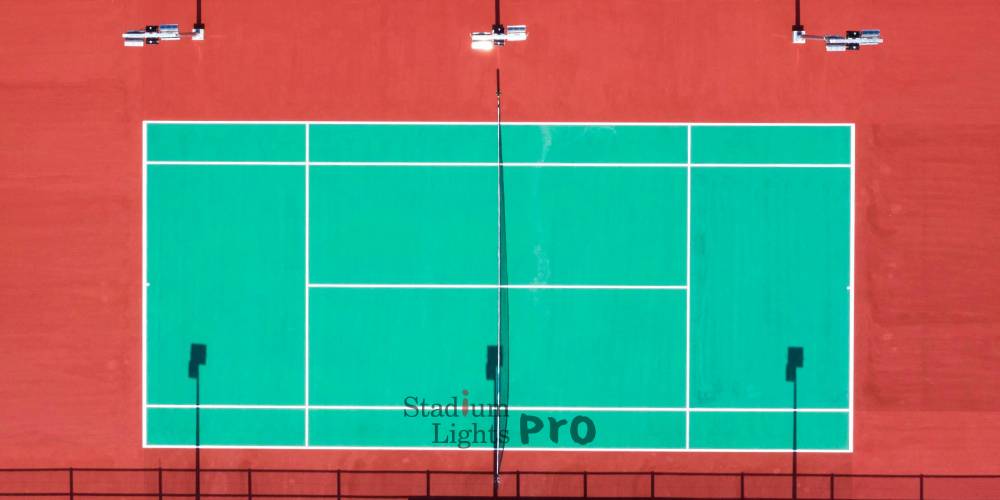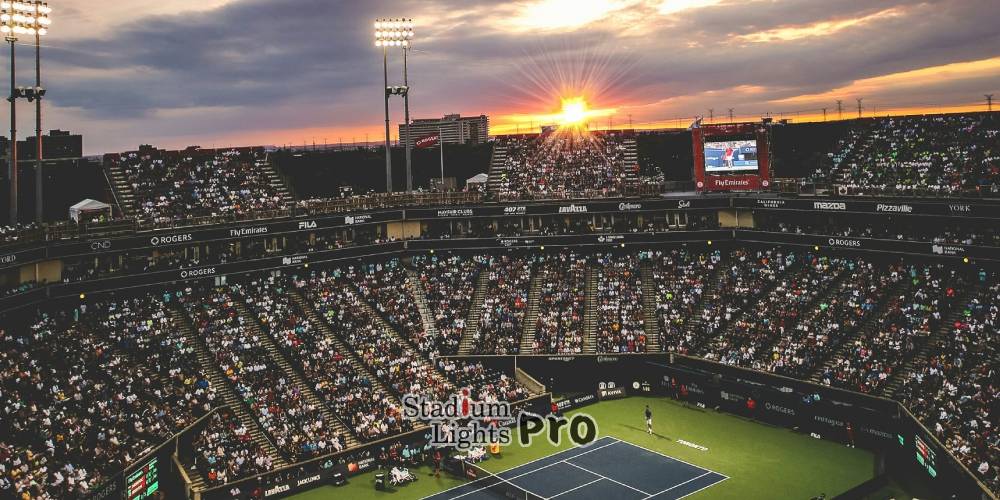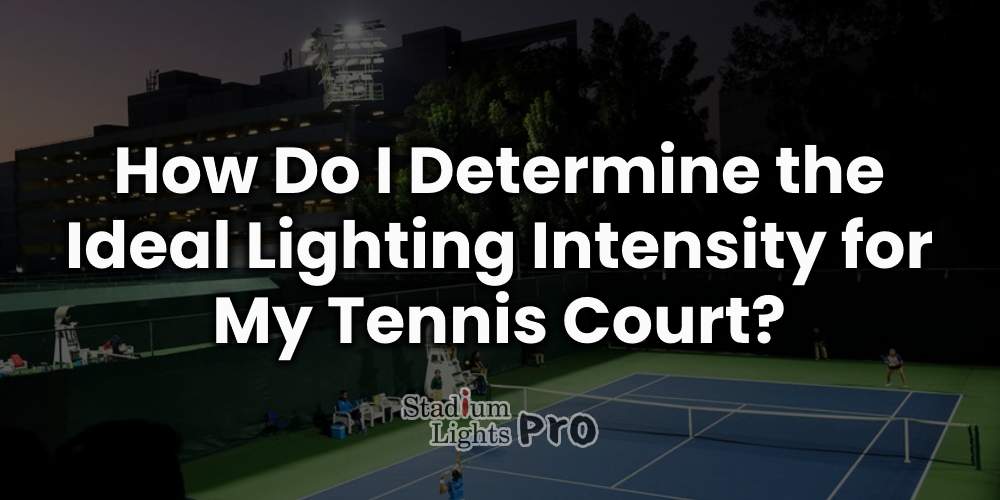Table of Contents
ToggleHow to measure lighting intensity of a tennis court
To accurately measure lighting intensity on a tennis court, begin by preparing the area during typical playing hours, ensuring all fixtures are operational and set to standard levels. Divide the court into sections and take multiple measurements at various points within each section using a lux meter held perpendicular to the ground. Record readings after stabilization and document them along with corresponding locations and timestamps to create a lighting intensity map for reference. Compare measured values against established standards, ensuring uniformity across the entire playing surface, and promptly address any areas with insufficient lighting. Implement a proactive maintenance schedule to sustain optimal lighting conditions, conducting regular inspections and measurements to monitor performance and address any issues promptly.
Lux requirement of different tennis court lights
Lux requirements for tennis court lighting systems vary depending on factors like the level of play and the technology employed. Standard metal halide lighting typically ranges from 200 to 300 lux for amateur play and can exceed 500 to 1000 lux for professional tournaments.
LED lighting systems offer greater efficiency and uniformity, with lux levels generally falling between 300 to 500 for amateur courts and 700 to 1200 for professional venues.
High-pressure sodium (HPS) lighting, less commonly used, may require 200 to 400 lux for amateur play and up to 500 to 800 lux for professional settings. Adaptive lighting systems, which adjust lux levels dynamically, aim to meet the needs of players and environmental conditions.
Solar-powered solutions and floodlighting configurations further contribute to the variability of lux requirements, emphasizing the importance of considering factors like play level, sustainability, and regulatory standards when selecting tennis court lighting.
| Level of competition | Lux recommendation |
| Recreation | 200-300 |
| College | 300-500 |
| Competition | 800-1500 |
Recreation
For recreational tennis courts, the lux requirement typically falls within the range of 200 to 300 lux. These courts are primarily used for casual play and leisure activities, where the emphasis is on enjoyment rather than competitive performance. Lighting systems meeting this requirement provide adequate illumination for players to see the ball clearly and navigate the court comfortably during evening or nighttime sessions. Standard metal halide lighting is commonly used for recreational tennis courts due to its affordability, versatility, and durability. It offers uniform lighting across the playing surface, ensuring consistent visibility for players of varying skill levels.
Additionally, LED lighting systems are becoming increasingly popular for recreational courts due to their energy efficiency, longevity, and superior light quality. With their instant-on capability and dimming features, LED lights allow for precise control over lighting levels, catering to the specific needs and preferences of recreational players. Overall, meeting the lux requirement ensures a safe and enjoyable experience for individuals engaging in tennis as a recreational activity.
College

For college-level tennis courts, the lux requirement typically ranges from 300 to 500 lux. These courts cater to a higher level of play compared to recreational settings, as they are often used for collegiate-level competitions, team practices, and intramural matches. The increased lux requirement ensures optimal visibility and performance for players who may possess more advanced skills and require better lighting conditions to maintain accuracy and reaction times. Lighting systems meeting this requirement provide enhanced illumination across the court, allowing players to track the ball effectively and make precise shots. LED lighting systems are commonly favored for college-level tennis courts due to their efficiency, durability, and ability to deliver consistent and uniform lighting. With advanced features such as instant-on capability and dimming options, LED lights offer flexibility to adjust lighting levels according to specific training or match conditions. Meeting the lux requirement for college tennis courts ensures that players have the necessary lighting conditions to excel in their athletic pursuits and compete at their best.
Competition
For competition-level tennis courts, the lux requirement is typically higher, ranging from 500 to 1000 lux. These courts host professional tournaments, national championships, and high-level competitions where precision, speed, and visibility are paramount for players’ performance. The elevated lux requirement ensures that players can track the ball accurately and react swiftly to make decisive shots under intense competitive conditions. Lighting systems meeting this requirement must deliver exceptional illumination across the entire court surface, minimizing shadows and glare to provide optimal visibility for players. LED lighting systems are often the preferred choice for competition-level tennis courts due to their superior efficiency, longevity, and ability to produce uniform lighting. With features such as instant-on capability and dimming options, LED lights allow for precise control over lighting levels to meet the specific requirements of professional tournaments. Meeting the lux requirement for competition tennis courts is essential to ensure fair and competitive gameplay and to provide spectators with an immersive viewing experience.

Factors Influencing Ideal Lighting Intensity
Several factors influence the ideal lighting intensity for tennis courts, including court size and layout, environmental conditions, player preferences and skill levels, regulatory standards and guidelines, technology and fixture design, and budgetary considerations. The size and layout of the court dictate the distribution and intensity of lighting required, while environmental factors such as natural light interference and weather conditions impact perceived brightness. Player preferences and skill levels, along with adherence to regulatory standards, ensure safety and optimal performance. Advances in lighting technology and fixture design offer opportunities for optimization, while budgetary constraints and operational considerations influence decision-making. Balancing these factors is crucial to determine the ideal lighting intensity that provides consistent visibility, enhances gameplay experience, and meets both functional and financial objectives.
International standards
International standards for tennis court lighting establish guidelines and specifications to ensure consistent and optimal illumination for players and spectators. These standards are formulated by organizations such as the International Tennis Federation (ITF) and the International Commission on Illumination (CIE). They encompass various aspects of lighting design, including minimum lux levels, uniformity ratios, glare control, and color rendering. For example, the ITF recommends minimum lighting intensities ranging from 200 to 750 lux for recreational, club, and professional-level tennis courts, respectively, with uniformity ratios not exceeding 0.7. Moreover, standards address factors such as the positioning and orientation of lighting fixtures, aiming to minimize shadows, glare, and light spill onto adjacent areas. Compliance with international standards ensures safety, fairness, and optimal playing conditions across tennis facilities worldwide, contributing to the overall quality and integrity of the sport.

Size, layout, and orientation of the tennis court
The size, layout, and orientation of the tennis court are crucial factors influencing lighting design and intensity. The dimensions of the court, including its length, width, and height, determine the coverage area and distribution of light required for consistent visibility. Furthermore, the layout, such as the placement of sidelines, service lines, and net poles, affects the positioning and orientation of lighting fixtures to minimize shadows and glare. The orientation of the court relative to natural light sources, such as the sun, also impacts lighting design, with considerations for controlling direct sunlight and maximizing uniformity of illumination. By carefully assessing the size, layout, and orientation of the tennis court, lighting designers can tailor lighting solutions to ensure optimal visibility, safety, and performance for players and spectators alike.
Environment
Environmental conditions play a significant role in determining the effectiveness of lighting on tennis courts. Factors such as natural light interference, weather conditions, and surrounding ambient light levels can influence the perceived brightness and uniformity of artificial lighting. Natural light interference, including sunlight and moonlight, can create contrasts and shadows that affect visibility and player performance, particularly during outdoor matches or events held during twilight hours. Weather conditions such as rain, fog, or haze can further attenuate light levels and reduce visibility, necessitating adjustments to lighting intensity or fixture configurations. Surrounding ambient light from nearby buildings, streetlights, or other sources can also impact the perceived brightness and color rendering of artificial lighting, requiring measures to mitigate glare and maintain consistency. By considering these environmental factors, lighting designers can optimize illumination levels and ensure optimal playing conditions for tennis players, regardless of external influences.
Player preferences
Player preferences play a significant role in determining the ideal lighting intensity for tennis courts. Preferences can vary based on factors such as age, visual acuity, and individual comfort levels. Some players may prefer higher lighting levels for enhanced visibility and clarity, while others may find excessively bright lighting uncomfortable or distracting. Besides, players with different skill levels may have varying requirements, with beginners potentially needing more pronounced illumination to track the ball effectively, whereas advanced players may prioritize lighting consistency and glare reduction for precise shot-making. Preferences regarding color temperature, uniformity, and glare control also contribute to the overall perception of lighting quality. By considering player preferences, lighting designers can tailor lighting solutions to accommodate diverse needs and ensure an enjoyable and optimal playing experience for all tennis enthusiasts.
Adjustments
Adjustments and optimization are crucial for ensuring tennis court lighting meets players’ needs and maximizes performance. This involves fine-tuning fixtures and controls to achieve optimal illumination, uniformity, and glare control. Dynamic lighting controls allow real-time adjustments based on environmental conditions and player preferences.
Fine-tuning lighting fixtures
Fine-tuning lighting fixtures involves making precise adjustments to optimize their performance and meet specific requirements. This may include adjusting the angle, orientation, or intensity of the fixtures to achieve optimal illumination levels, uniformity, and glare control. Fine-tuning ensures that the lighting effectively covers the entire playing surface of the tennis court, minimizing shadows and hot spots while providing consistent visibility for players. Additionally, fine-tuning may involve addressing any issues related to light spillage or excessive glare that could affect player performance or spectator comfort. By fine-tuning lighting fixtures, tennis court lighting systems can be optimized to enhance the overall playing experience and meet the needs of players and spectators alike.
Dynamic lighting controls for adaptive illumination
Dynamic lighting controls enable adaptive illumination by allowing real-time adjustments to lighting levels and configurations based on changing conditions and user preferences. These controls provide flexibility and versatility in managing tennis court lighting, ensuring optimal visibility, comfort, and energy efficiency. For example, sensors can automatically adjust lighting levels in response to natural light levels, saving energy during daylight hours while maintaining consistent illumination. Moreover, programmable controls allow for customized lighting scenarios tailored to specific events or activities, such as matches, practices, or tournaments. By incorporating dynamic lighting controls, tennis court lighting systems can adapt to varying needs and conditions, enhancing the overall playing experience for athletes and spectators while maximizing energy savings.
Optimization
Optimization involves refining and improving the performance of tennis court lighting systems to enhance functionality, efficiency, and overall effectiveness. This process encompasses various strategies aimed at maximizing lighting quality, minimizing energy consumption, and ensuring compliance with regulatory standards. In addition, proactive measures such as regular maintenance, performance monitoring, and adjustment of dynamic lighting controls contribute to sustained improvements and enhanced player experience. Optimization efforts prioritize energy efficiency, minimize light spillage, and maintain compliance with evolving standards, ultimately elevating the overall quality and sustainability of tennis court lighting.
Efficiency Enhancements
Efficiency enhancements involve implementing strategies to improve the energy efficiency of tennis court lighting systems while maintaining or enhancing performance. This may include upgrading to energy-efficient LED fixtures, optimizing fixture placement and orientation to minimize wasted light, and implementing intelligent lighting controls that allow for precise management of lighting levels based on usage patterns and environmental conditions. Efficiency enhancements may involve retrofitting existing lighting systems with advanced technologies such as motion sensors or timers to ensure lights are only active when needed, further reducing energy consumption and operating costs. By prioritizing efficiency enhancements, tennis court facilities can reduce their environmental impact, lower energy bills, and improve the overall sustainability of their lighting infrastructure.
Light Spillage Reduction
Light spillage reduction refers to the implementation of measures aimed at minimizing the unintended dispersion of light beyond the boundaries of the tennis court. This includes controlling and directing the distribution of light to ensure it remains focused on the playing surface, thereby reducing glare, light pollution, and potential disturbance to neighboring areas. Strategies for light spillage reduction may involve adjusting fixture angles and shielding to limit upward and sideways light emissions, as well as optimizing lighting intensity and uniformity to minimize excess light spillage. Moreover, the use of precision optics and specialized luminaires can help contain light within designated areas while enhancing visibility and player comfort on the court. By effectively managing light spillage, tennis court facilities can improve lighting quality, enhance environmental stewardship, and foster positive relationships with surrounding communities.
Compliance Maintenance
Compliance maintenance refers to the ongoing efforts to ensure that tennis court lighting systems adhere to relevant regulatory standards, guidelines, and industry best practices. This involves regular inspections, performance evaluations, and adjustments to ensure that lighting levels, uniformity, and glare control meet or exceed established requirements. Compliance maintenance also encompasses periodic assessments of lighting fixtures, controls, and configurations to identify any deviations or deficiencies that may affect performance or safety. Compliance maintenance may involve updating lighting systems to align with evolving regulations and technological advancements, as well as educating stakeholders on the importance of compliance and the benefits of maintaining high-quality lighting standards. By prioritizing compliance maintenance, tennis court facilities can uphold safety standards, enhance player experience, and demonstrate their commitment to excellence and sustainability in lighting design and operation.
Performance Monitoring
Performance monitoring involves the systematic tracking and evaluation of tennis court lighting systems to ensure they consistently meet established standards and performance metrics. This process includes regular assessments of lighting levels, uniformity, glare control, and energy consumption to identify any deviations or inefficiencies. Performance monitoring may involve the use of sensors, meters, or data logging systems to measure and record relevant parameters over time, allowing for trend analysis and early detection of potential issues. Performance monitoring may include subjective feedback from players, coaches, and facility managers to gauge the effectiveness of lighting systems in meeting user needs and preferences. By proactively monitoring performance, tennis court facilities can identify opportunities for improvement, optimize lighting systems, and maintain high-quality illumination for players and spectators alike.
Conclusion
By using lux meters to measure light levels across the court, comparing results to recommended lux requirements, and regularly monitoring and adjusting the lighting system, tennis courts can provide consistent, high-quality illumination. Consideration of player preferences, environmental conditions, and modern technologies like LED lighting and dynamic controls also enhances the overall experience for players and spectators while improving energy efficiency and reducing light spillage.

